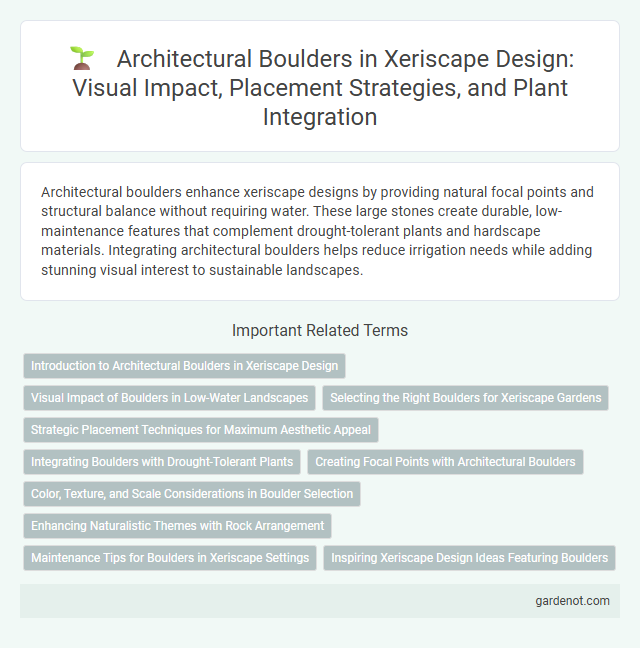Architectural boulders enhance xeriscape designs by providing natural focal points and structural balance without requiring water. These large stones create durable, low-maintenance features that complement drought-tolerant plants and hardscape materials. Integrating architectural boulders helps reduce irrigation needs while adding stunning visual interest to sustainable landscapes.
Introduction to Architectural Boulders in Xeriscape Design
Architectural boulders play a crucial role in xeriscape design by providing natural focal points that enhance drought-tolerant landscapes. These large, strategically placed stones help reduce water usage by minimizing the need for extensive plantings and irrigation. Incorporating architectural boulders adds texture, structure, and visual interest to xeriscapes while promoting sustainable landscaping practices.
Visual Impact of Boulders in Low-Water Landscapes
Architectural boulders create striking focal points in xeriscape designs by adding texture, depth, and natural artistry to low-water landscapes. Their substantial size and varied shapes enhance the visual hierarchy, breaking up monotony and providing contrast against drought-tolerant plants. Strategically placed boulders maximize curb appeal while minimizing irrigation needs, reinforcing sustainable landscaping principles.
Selecting the Right Boulders for Xeriscape Gardens
Selecting the right architectural boulders for xeriscape gardens involves considering size, shape, and color to complement drought-tolerant plants and natural landscaping. Opt for boulders with varied textures and hues, such as weathered sandstone or granite, to enhance visual interest while conserving water. Strategic placement of these boulders can create focal points, retain soil moisture, and reduce erosion in xeriscape environments.
Strategic Placement Techniques for Maximum Aesthetic Appeal
Strategic placement of architectural boulders in xeriscape design enhances visual interest and defines outdoor spaces by creating natural focal points and guiding movement. Positioning boulders at varying heights and angles mimics natural formations, promoting harmony with drought-tolerant plants and reinforcing sustainable landscaping principles. Integrating boulders near pathways or water-efficient ground covers maximizes aesthetic appeal while optimizing water conservation benefits.
Integrating Boulders with Drought-Tolerant Plants
Architectural boulders create focal points and natural structure within xeriscape gardens, enhancing visual appeal while supporting water conservation efforts. Strategically placing drought-tolerant plants like agave, yucca, and sedum around boulders maximizes soil moisture retention and reduces irrigation needs. This integration promotes sustainable landscaping by blending hardscape elements with resilient vegetation adapted to arid environments.
Creating Focal Points with Architectural Boulders
Architectural boulders serve as striking focal points in xeriscape designs, combining natural textures and bold shapes to create visual interest while conserving water. These strategically placed stones enhance garden aesthetics by guiding the eye and providing contrast against drought-tolerant plants. Incorporating architectural boulders reduces maintenance needs and emphasizes sustainable landscaping principles.
Color, Texture, and Scale Considerations in Boulder Selection
Architectural boulders in xeriscape design demand careful color selection to complement drought-tolerant plants and natural surroundings, often favoring earthy tones like rust, tan, or gray. Texture plays a crucial role, with rough surfaces enhancing visual interest and mimicking natural rock formations, while smooth textures provide contrast and modern appeal. Scale consideration is essential, as oversized boulders can dominate the landscape, whereas moderate-sized stones balance aesthetics and functionality, creating focal points without overwhelming the space.
Enhancing Naturalistic Themes with Rock Arrangement
Architectural boulders play a crucial role in xeriscape design by reinforcing naturalistic themes through strategic rock arrangement that mimics native landscapes. These large stones provide structural focal points, adding texture and depth while promoting water conservation by reducing the need for irrigation. Properly placed boulders create visual interest and habitat for drought-tolerant plants, enhancing overall ecosystem sustainability in dry environments.
Maintenance Tips for Boulders in Xeriscape Settings
Architectural boulders in xeriscape settings require minimal maintenance, primarily focused on preventing soil erosion and controlling weed growth around the rock base. Periodic inspection for moss or lichen buildup helps maintain the boulder's aesthetic while ensuring it doesn't trap excess moisture that could affect drought-tolerant plants nearby. Applying a natural sealant can enhance the boulder's durability against weathering without compromising the xeriscape's water-conservation goals.
Inspiring Xeriscape Design Ideas Featuring Boulders
Architectural boulders serve as striking focal points in xeriscape gardens, enhancing both aesthetics and water efficiency by minimizing irrigation needs. Strategically placed natural stones create texture and structure, complementing drought-tolerant plants such as succulents and native grasses. Incorporating large boulders into xeriscape design not only conserves water but also adds durability and a timeless visual appeal to sustainable landscapes.
Architectural boulder Infographic

 gardenot.com
gardenot.com